
Rev/Ph Page 5

Internet pages One Two Three Four Five
Chapter
10
RIGHTS
OR LEFTS
That our left hand is no different from our right hand except for its location is common knowledge, and that the direction of magnetic motion in the earth is the same at the North Pole as at the South Pole also is common knowledge. Yet with that we call north a north, and south a south, even as our left and right are what we call them. The distinctive difference in their location being one factor, and the direction to or from the body being the other factor.
When we say the motion comes out at the north, we say, see here this end of the ball is positive in charge, and when we see the motion going inwards at the south, we say, see here this end is negatively charged, for by a measuring device one end acts just opposite of the other. The probe can only tell directions of motion, and its intensity.
At both poles therefore the probe will tell us that the motion is equal in intensity and going the same direction, but unto our eyesight the right side of the probe was near the surface at one place, while the left faced it on the other. And with coordination we can tell the difference, and why this difference exists.
To get down to business therefore, if everything in nature tells that one is precisely identical to the other, a difference existing only by a point of view, should we then continue to think of charges as separate individual beings? Or continue to realize positives and negatives as elements of a distinct nature?
I would suggest that the time has come for us to finally accept for ourselves that this world is round indeed instead of franticly hanging on one edge of a flat world contending that it is safer then on the rounded surface of the other side.
Anyone with a magnet and some filings can conclusively prove to himself the motion and lines or directions of motion to be one and the same from a north pole to the south pole of another magnet. And when he faces two identical poles together that the motions oppose each other. Moreover they always follow the motion of their figure of eight, and when these motions face each other so their direction is in one common direction they unite together as can be seen with the naked eye. While in reverse the pattern of their lines will pull back to their individual designs respectively. What all does this tell us? It tells just what we have been saying.
It is quite understandable how when we are unaware of the nature of energy, and of the process by which nature sets forth energy, together with not realizing how a positive and negative charge differentiate from one another, to arrive at quite a number of atomic particles which appear to be of all different kinds. Yet when we throw a solid rock at a number of other ones, and bits and pieces are flying everywhere, we name not each one differently, but they be big rocks or little rocks.
To label particles as different size or direction, or time in velocity may serve as one means to distinguish a one inch rock from a two inch rock or half inch, but by the same token we could distinguish them by a number of size or velocity, and point their direction at which time it becomes a factor of value rather than the nature of it. However we do it makes little difference to me except we should not begin to think of them as a different nature. And I for one would prefer the common means of value as it is my contention to narrow all things down to their bare and naked simplicity whenever possible. The complication of things is after all not a virtue of knowledge.
When we eye electricity and its mode of travel I perceive something rather ironic. It is common practice that each man speaks of his own, but I hope to bring out a point wherein I must not only speak of my own but speak the words that others are speaking also, yet not realize they are so speaking them of their own contention while on the contrary they would place mine in error against their own identical outcome.
The velocity of an electric current for example is equal to the speed of light, all of which are propagations of electro magnetic waves. Having this established agreement at this point, let us question the validity of electrical currents as a stream of electrons moving through solid metals.
In Figure 55 let us assume that a ray of light designated by A, causes an electron B, to accept the vibrations of that part of the picture which must be transposed to a television set many miles away. Electron B, is part of a photosensitive plate or screen, and remains fixed while electron C, is one of the particles of the stream of electrons traveling in the cathode tube. From this plate (electron B.) to point D, where the rest of the way it is fed through wires and tubes into the mast and out into the air on its way to another antenna.
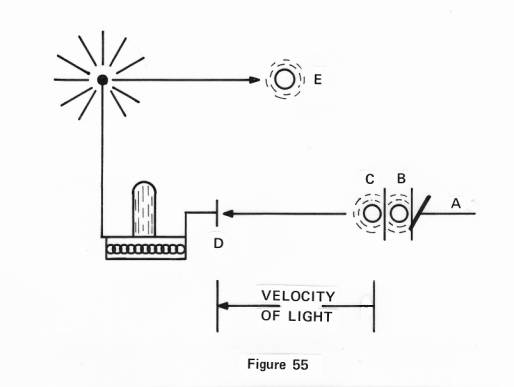
If electron B, has thus assumed these vibrations of the light it must hand these over to electron C, and then this electron must speed away from that point at the speed of light in order to deliver this part of the picture many miles away within that fraction of time.
But now immediately there is something wrong, for we know for a fact that when we direct a beam of electrons in an accelerator which are not yet traveling at the speed of light at a material point, they easily cause an atomic reaction. Therefore a stream of electrons at that velocity and higher should by all means take good care of our set and then some. It is therefore much too illogical and in violation of all experiments for electron C. to do this.
Our next item is that we saw
electron B hand over the vibrations to the electron C.
Therefore it would not be so strange to assume that this latter
electron could hand it over again to
still another such as an electron in the cathode at point D. But in order to
maintain our velocity, it immediately implies that electron C had better get
from B to D at the speed of light and take on and hand over its message
without any loss in time.
Yet then we are back at our first
conclusion, being left with a set being disintegrated by an atomic reaction.
So then we take the bull by the horns and say, "But the electrons
themselves do not travel that fast. The message is transported by
electro-magnetic waves, radiated from the electrons." But if I understand
it correctly we do in fact state that the light gives its vibration to the
electron, and other electrons take it over.
And then they are to give this to electro-magnetic waves? Why did the light not give it to these waves to begin with? And in that case, why do electrons have to travel at all if they let somebody else do their work for them? Are we actually saying that electro-magnetic waves are set forth by the motion of the electrons? And they set forth a wave that can possess an actual vibration, a fluctuating movement, which is cast forth by these electrons at the speed of light, while they themselves travel much slower?
Before we answer this, let us review this point in Figure 56. Suppose our former points in the cathode tube are now represented by points G and H, between which a whole stream of electrons is traveling and each electron must hand over the message of vibrations to the next in line, and let us suppose that they can do this as fast as the speed of light. Shall we then get our message across these points at the speed of light?
No, of course not, for any
distance at all which any electron must travel to reach another one to
transfer its cargo unto, will restrict the total velocity to the velocity at
which the particle is moving.
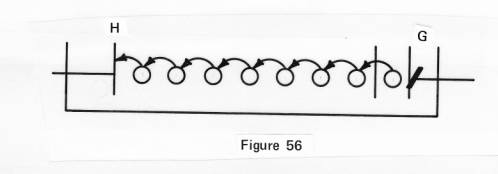
And if we suppose that they throw the message over, like rocks to one another, I fear to think what might happen to our original message seeing that the postal service does not throw things yet our arrivals are not always in the best of shape. And to think that electrons are lined up side by side to eliminate their travel does not correspond with our experiments. What has become obvious, however, is the fact that the velocity of the electrons, and their travel altogether, has become irrelevant to the confirmed fact that our message does reach its destination at the velocity of light.
Thus let us go back to our electro-magnetic waves, which are set forth by either the movement or the charges of these electrons, and we figure to pick out again the variations in the void upon substantial things to again project these.
When we take a line of electrons as in Figure 57 and assume them to cast motion into a wave of harmony, like setting up a line of motion, and to cast forth this wave of motion at the speed of light, which is much faster than their own forward motion, we gather that they use a trick of multiplication, something similar to that which we discussed with our radio wave, perhaps, in unity or a combined effort.
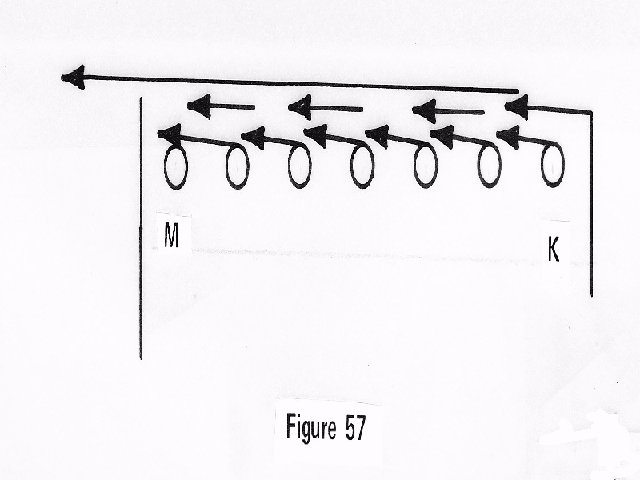
And we ask ourselves, what is the electro-magnetic wave that comes from them, or by them? It matters little whether we call it a void, or motion, or relations, or Henry Jones. The fact remains that something, that is a variations of movements, moves away at high speed from them, and as over them.
Consider now for the moment, how the lines of motion, or waves, by their nature as I have defined them, are essentially the same as we have defined them ourselves. Consider for yourself how simple a variation of a void may be upon a motion set forth by the unity of many electrons. As we see in Figure 58.
If we represent each electron by a single line beginning at point 0, how within this section of a length up to point P the position has changed one-fourth of a cycle, and although this is certainly not a variation of a void, or a displacement that we normally would call a void, nevertheless, the electron at 0 is still there, while the one at P has already recorded the message.
As a line, looking from right to
left, P and 0 are the same, yet one is to our right and the other to our left,
and in this relation we obtain a difference only by these two points and our
eyes or any other mechanical means to account for such differences.

We began at a difference, each one stating electricity is this form of things, and we end by stating the same basic thing. Why should we any longer call it a void then? Let us smooth off the uneven parts and stand united. If it is conceivable that a void may transmit the variations of a line of particle motion, which is other than their own velocity, it should be even more conceivable that variations may be transmitted by the forward motion of that motion of variation itself.
And at the same time it should be
quite obvious that electrons singularly are not likely to be able to promote
this high velocity feat, but by a systematic multiplication of quite a number
of them, it becomes highly conceivable, which has the immediate implication
that electro-magnetic waves are spaced
systematically, and will have to be the very entities which cause and promote
these very actions, everywhere, from transmitter to receiver, etc.
This is perhaps a devious way for me to say what others say, to say what I am saying which is what they are saying, but say that I am not saying.
Chapter
11
CONTRAST
To contrast is to exhibit un-likeliness by comparison which is exactly what my intensions are herein, and let us begin with a little bitty one which still makes a world of difference, in fact our world, this concerns.
The Seasons
Everyone is agreed on the fact
that by the tilt of the earth we experience summer and winter in their
respective hemispheres, but how do we change seasons in one year? When
we take a ball, like our earth in Figure
59 at point A, and fasten it so that
it has a tilt as indicated, and we swing this ball around in circles, then the
angle of tilt remains constant. On the other side of a circle the ball, and
consequently our earth at point B, is still holding an identical position
such as it started with.
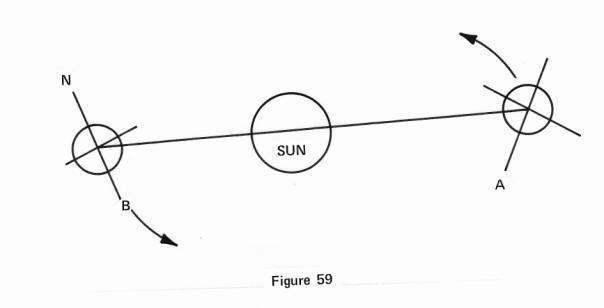
In this constant position, however, we would never have a change of seasons, for the north pole would always face away from the sun. It must have its angle of tilt in the other direction at B. So then we explain it. The earth remains constant in its position, and beginning at point A, we figure the whole half that faces the sun to switch around so that in a constant position, the earth will have its tilt at B in the opposite direction.
Now this may sound fine and dandy for a spaceship which is not connected to a sun and has no relation of power to hold it in a circle by that sun or to that sun. In such a manner it could move in a circle or in a straight line from A to B. But our earth is very much held to the sun by a very strong rope, lest we be all over in the galaxy, and by this rope we have an indelible relation with the sun as regards our mode of travel and angle of position.
Take a gyro therefore, for our earth is also a gyro, and we place its angle, and pull it around by its center. Then it will remain in that position as demonstrated in Figure 60 except and unless the gyro is processing, for by a precession the earth will tilt its angle as it goes along, and by one turn of precession for each turn of orbit, we have our change of seasons, as may be demonstrated in Figure 60 where point C, at the axis, must change to a position indicated by D, in one-half a circle.
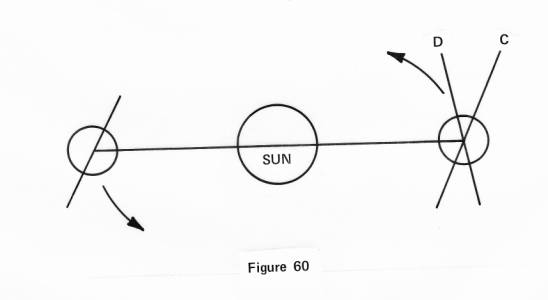
The reason that I think it unlikely for the earth to hold a constant position, and I should not teach otherwise until some concrete proof to the contrary can be observed, is by the manner the sun holds us. For we are held by the center of our force, as we see in the figures, and note how the line of the sun, or a rope as we might say, passes through the southern hemisphere, which would account for a point of balance, I suppose, if the earth were idle, but it is not.
Therefore as the earth moves in orbit holding a position as we currently determine, the line of the sun must cross over the equator continually twice yearly, and this switching to me means a point of motion, and potential opposition to be formed, forcing the earth into a movement of precession. And our small movement of nutation can not properly account for that, while an angle of 23-1/2 ° is more like it.
Of course as the earth precesses, it crosses the line of the sun twice yearly also, but the difference is that the line of motion of the sun, moving through out magnetic force in a figure-eight, is joined, so to say, by the motion of the earth. Just as if the earth had a groove carved at its equator, going above and below the line of the ecliptic, and our line of the sun is a shaft, the earth will precess as the ridgidness of the shaft forces a curved path to follow a straight line.
Suppose the earth did remain constant and yet we had our seasons, then one and the same pole would always point the same direction. But in a precession, the one and same pole would also point in the same direction throughout the year, and by that we can not tell the difference.
Considering the earth to rotate towards the east, and looking from north on down, the earth turns counterclockwise. From the same point of view, it moves counterclockwise around the sun, while its precession is in a clockwise rotation on the north pole. It is literally murder trying to get some basic information from the general information literature, but these are the motions they should be making, although it is difficult to be sure of them, and I don't trust the books that well in these respects.
The only satisfaction I have for the precession of the earth to account for the seasons is in the laws of motion: simply, that two working potentials can not hold their line in a perfect rigid balance. They should by all means follow the pattern of a figure-eight, and just how to prove that it is correct by the motions is the sky is rather difficult since by the idea of a constant earth, the same pattern of motion would follow. Perhaps with some decent information, it might be substantiated other than by laws of motion.
The Tides
Our next subject of contrast regards the tides, but yet more it is concerning the laws and principles of force and action, and equal action to reaction.
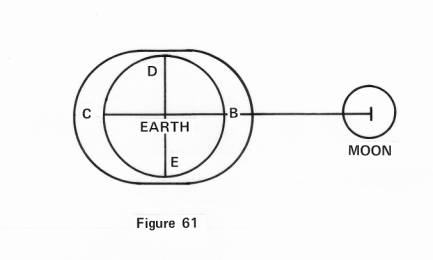
Figure 61 shows the earth marked by five points, the show of the tides, and the moon pulling on the earth. It sound logical that if gravity did indeed pull on earth, that the waters at B, nearest the moon, would be attracted more strongly than anywhere else, causing a high rise of water there, and pulling not so much on the poles, would be less there.
But pulling still less at point C, the far side of the earth, the water should not rise at all but go down instead, because the volume of water around the earth remains constant.
And if it rises at point B, it will flow around the globe and the poles to that point, leaving the far side of the earth, whose waters are being pulled the least to have no choice, but to begin flowing towards those lower parts by the very force of gravity which pulls all things equally everywhere, and whose center of force changes not, to give any different amounts of pull anywhere, and even if it did, the force would equalize itself by its very law of equivalence. Yet the water rises instead at that far side, in gross violation of these laws.
If then we suggest that the moon pulls on the entire earth at equal force everywhere, because it pulls as from center, which is indeed in agreement with the law, it does indeed make it true that the moon would pull more on the waters near it than on the earth at the far side thereof. But that explanation is evading the question of the rise of the waters at that far side (side C. For consequently if the moon pulls on the earth at every point thereon equally we can just as well eliminate it in respect to the solid part, as making any difference in the waters anywhere.
We do not mean to say that the moon physically moves the whole earth out of its path of motion continually so that by force of acceleration we might consider the solid part to have an advantage on the waters to the direction of the moon. I hope not anyway, or we'd be shaking hands with Pluto before long.
All in all, what other determination could be made to have the solid part of the earth make a difference in the way the waters are pulled by the earth? For if the earth moves at all we contradict ourselves in our theory of equalization of force and center pull, and moreover, at side B raising the solid part would not raise the water much above the level we usually mark it, and it is not likely that side C would be pulled backwards or inwards.
And if they were at all, we should find the specific gravity to change continually, or move the center of force, none of which we experience anywhere. Let us mark our point of difference again. We explain the rise at C because the moon pulls less on the earth at C than it does on the water at B.
Now if I am not mistaken, and considering all things I would say that these words are the same as saying, "The reason it rains is because the water in the clouds are at five o'clock in the afternoon," for what could the first part have to do with the second part? The earth is pulled not so strongly at C, but not at B either. In fact they are pulled at equal force.
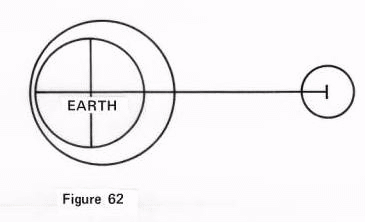
If therefore the moon pulled stronger at the waters near the moon, and less at the waters on the far side, and the earth is pulled with equal force on both these sides, there must be difference to be sure or I am losing all sense of rhyme and reason, together with the great majority of all people everywhere, if not every one of us. If the moon pulled by gravity at all, the Figure 62 should be the correct way the waters always rise. I said provided it were gravity.
Let us consider a tug of war between our lady in the sky and us. Who is stronger in its gravity? We are! Shall our good-looking lady up there, with her soft hands, be able to move a bucket of water from our person, when we are pulling stronger than the total of her strength?
The Compass
Our next subject concerns a little needle which has held all of us blind to its actions, and neatly deceived us in putting the magnetic north at a location where it could not possibly exist. The magnetic force of the earth is donated to it by its spinning action in the system of the sun, like an armature in a generator, and by the very motion of that spin it can not but center on that axis. There are no two ways about it. And I should hope we do not think that there is a big steel block hidden in the earth that is a magnet and has shifted.
Figure 63 shows the earth and its magnetic force flowing in its figure-eight, and the assumed locality of the magnetic center. But our little compass needle is a magnet also, and it will follow the motion of a magnet no matter where we put it. Therefore it will point on the side of the center of the magnetic force. Realize for yourself how a compass within the earth's lines of force, it will point away from the center, and we can demonstrate it to ourselves with two magnets, a larger one for the earth and a smaller one for the compass.
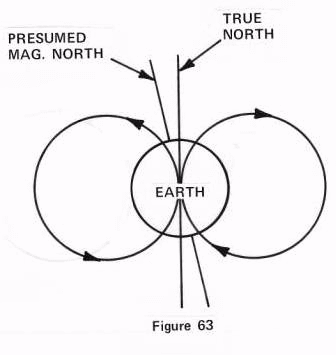
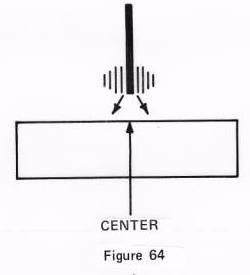
As shown in Figure 64, mark the exact center of the magnetic bar from both sides so there is a mark at the exact center only, and now try to get the other magnet to point to your true magnetic north. You can suspend one if you wish for better observation, and as you try this, note how at various distances or vibrations of your movement one magnet will move back and forth in the figure-eight pattern.
Not that one magnet will make a figure-eight in that precise movement, because the weight of the magnet, versus its velocity, will break through that pattern, and begin once again, etc. Identical size magnets may be used to demonstrate the flow of their movement, but two poles of equal size will pull upon one another by the very width of their motions and draw center to center of course. Therefore to best duplicate the size of the earth versus the compass needle, use appropriate size magnets.
A more detailed version hereof, and of the previous contrasts, is stated in my first volume.
Chapter
12.
MYSTICAL
I
am a foolish man and do foolish things, and this is one of them, yet I do them,
for my heart is filled with sadness for a people not my own.
Have
we not reason? Are we not able to discern right from wrong, and what is to our
left from that which is to our right? Certainly, for we are not left altogether
without insight. Let us reason
therefore, and make a difference between our right hand and our left hand, to
know one from the other.
Suppose
we take unto ourselves two points, A and B as in Figure 65,
and let us take one
particle of light marked C to travel between these points as shown. C, therefore
will require a certain length of time to cross the distance. But suppose we
moved these two points
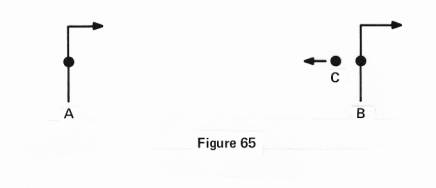
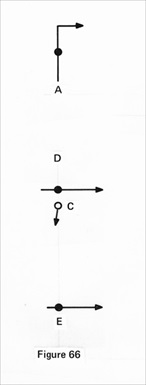
But
suppose now that in trying this out for real, it would not gain in time, and
that no matter how fast or how slow, or in what direction we moved these points,
A, and B, particle C, will constantly cross the distance at its own time of
velocity, totally disrespecting any movement we make to the points together.
Our
first answer to this would be that C, could not possibly move independently of
the medium that exists between the points and which moves with the points as we
move the points together with the medium in their single motion.
And our answer is quite correct. We
require but to visualize a toy car upon a truck bed, and cross the bed of the
truck from front to rear or sideways. The
movement of the truck itself changes not the velocity of the toy car riding upon
the bed of the truck in motion.
Yet
if we persist that particle C, is not dependent then good luck trying to explain
why it behaved the way it did. And we came up with a theory that at the speed of
light distance is contracted. Now I realize that you are asking, "What does
that mean?" for as illogical as it may be, yet let us review it.
It means in essence that, since the light should cross the distance in
less time, but in fact it does not, the motion of the earth stands still when
the light passes between these points.
We
are getting more illogical now, and yet this should be correct because the
forward motion of A-B is the earth's velocity as they are secured to the earth.
And since this forward motion refused itself to be subtracted from the
time and velocity of the light, we said that at the velocity of light things go
slower, and this difference is the velocity or motion of the earth.
Therefore, technically the earth stands still when we pass light between
two points against its direction of motion.
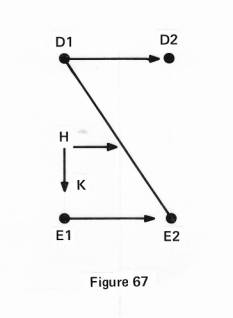

Now
let us try something else. Let us take two points D, and E,
(Figure
66) one above the other
so that as they move in the direction as indicated the particle of light must
travel at right angles thereto, and thus not moving against any motion it must
require its full time to cross the distance according to its own velocity.
In
trying this out this proved to be correct.
But are we not implying something else here? For is it not a fact that if
C moves independently of these points then by the time C arrives at point E,
that point will no longer be there but it will have moved up by the very motion
of the earth?
Particle
C should therefore miss the whole
point, yet it did not. Instead, it did arrive at point E which again must imply
that the nutty particle did not hit the target we shot it at like our former
particle we shot at A, and never missed it.
It did therefore not move in a straight line, but it moved sideways with
the motion at D and E, as much as it moved sideways with the motion of D and E,
demonstrated by arrows K, and H. And this might be considered a straight line
also if we say straight line in an angle (see figures 66 and
67)
Now
how in the world is it possible for that particle that must move independently
of the motion of the earth by points D, and E to move sideways with that motion
at precisely the speed of that motion? Now
we can sit here for 50 years and scratch our heads about it, or we accept the
only logical conclusion that it most certainly moves DEPENDENT on the medium.
For
as the medium moves it moves with it with precisely the same movements just like
the little car on the truck bed. If
now we are going to say that distance is contracted, or that the earth stands
still for light we better also come up with some explanation for the fact the
same light will not move in a straight line in one instance, but that it
will move in a straight line in other instances.
Let
us take one more experiment as in Figure 68, to have two points A, and C, and
these are moved into direction D at whatever speed one wishes. Then let us this
time really and accurately contract the distance so that the particle of light
marked E, when shot towards A, moves against a point moving towards it. We shall
let C, remain fixed but construct A, so it moves towards C, at the same time
when the light E, moves towards A.
Then
the time required for E, to cross this full distance will be shortened by
precisely the velocity at which A, moves towards, C. And yet this should be
impossible according to the theory of relativity because at the velocity of
light things move slower and theoretically there should be no gain, and by no
means the precise difference. Or should I only assume what is convenient? For
are the two not basically the same?
The
motion of A towards C is the same as the former motion of the earth, and we can
eliminate D from figure 68 if we wish, and the light from C, is the same as
before. And we did say "at the speed of light distance contracts, for
things to move slower. In basic
conception I therefore see no difference, but I can estimate the outcome of such
an experiment if anyone wishes to make it, which is that my words will be
correct, and the time in velocity will most assuredly be shortened, and no
distance will be shortened by it, except such as the motion of A, will dictate.
This
being the last chapter of this book one may have noticed that I am not a man to
make hypotheses, nor a man who conveniently eliminates himself from personal
responsibility by the making of, or according to postulates which will put the
blame on the physics of the theory rather than the person.
Let
us speak yet a few words concerning frames of references. In Figure 69, let us
be upon a point A, to move as indicated, but we consider ourselves to be at
rest, and let us have two stars B, and C, Let B, move faster than C,. We can not
then conclude which direction they are moving, nor how fast they are moving, or
if one of them moves at all, but only the difference in their velocities.
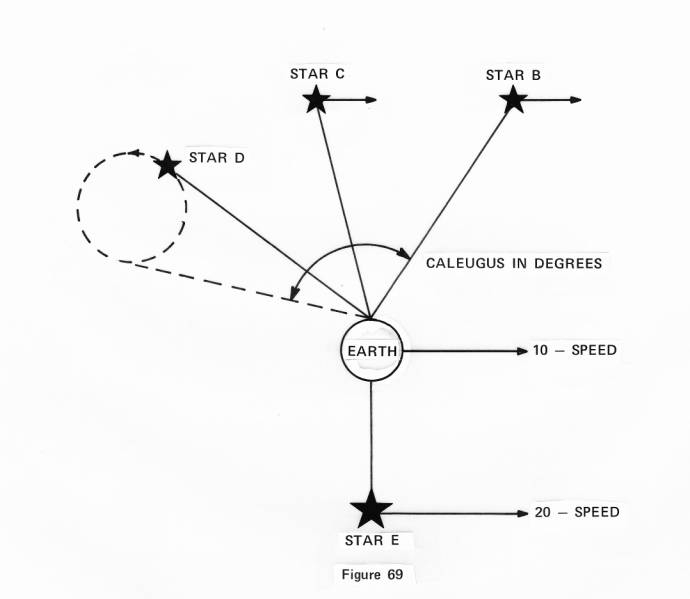
For example, if B, moves away from C, it could mean that they move a direction as indicated and B moves faster than C, or the recorded velocity is its speed, while C, is at rest. Or, it could mean that they move in the other direction and C, is moving faster than B.
If then we take another star such as D, and we have noticed that as it
moves in a definite circle, we can then better calculate the actual velocities
of the two stars by assuming and taking D, as a point of rest in space by the
very circle that it makes.
But all such velocities are still compared to D, a point at rest of which we can not be certain. For if it also moves in a linear fashion in addition to the angular motion, then our new velocities calculated are only measures of a difference, and no actualities. Then suppose there is another star E, moving as indicated at a velocity of 20, while we move at 10.
We
therefore considering ourselves at rest clock star E as moving at a velocity of
10. May we therefore say; "Star E has a velocity of 10"? No, but we
must say that star E has a velocity of 10 compared to ourselves as a point of
idle.
At
star E, now they could say that we moved in the opposite direction by a velocity
of 1, if they consider themselves at rest.
If either one however knows his own direction and velocity they can
calculate each other direction and velocity correctly.
Should now a clock run slower at star E, just because they are unaware of
their own motion?
Just
to be aware of a thing, or not to be aware changes not the speed at which a
thing moves, but it only proves us to err in our ways. A clock is set to make a
certain number of ticks per moment of time, which we arbitrarily have set in
order to make calculations and measure things for a difference. If then we set a
clock to tick slower, that is our problem if we want to change a standard for
calculating things against, but the motion of an object is not responsible
therefore.
And
if we place a clock in a rocket that we accelerate to high motion, and its
mechanism that we made to make certain ticks per second of time is so
constructed that the force of acceleration slows the mechanism down, then the
clock runs slower because we were children at making a proper clock to operate
correctly under such conditions. For
not the acceleration, but our failure to make a proper mechanism made the device
operate slower. We of course know better than to make such clocks to test such
things.
Electricity,
for example, moves away at the speed of light, so we have a vehicle that moves
at the speed which we desire, and upon it we may transpose something that is
like a clock, the ticks of a vibration, the rate of frequencies.
Shall now the rate of frequencies be faster at a point where we count
them in place from that of another point far away which they must first travel
to at the speed of light? Should these vibrations also come to vibrate slower
when they move that fast?
This
is the point, If we cannot be sure of a thing, we should not interpret them as
certainties, and if we calculate things by a difference from a set frame of
reference, they are valid as respecting the frame of reference, and not as an
absolute truth, unless the frame of reference happens to be an absolute truth.
Space,
matter, and motion are real, while time, distance, and velocity are mathematical
coordinates used to account for a difference of matter in motion against space.
They are therefore real to us because having assumed standards we can
measure the difference.
Let us not make living entities with a mind of their own out of stone cold standards of measures that exist only as calculus. Mathematics as we say may be used to prove things with, and if this is accepted, we should accept the same when applicable as disprove also. But mathematics shall not confirm these errors of the things we mentioned, and any man who sets forth such mathematics to prove them can be disproved by his own mathematics simply because two wrongs make no right.
One
could go on endlessly with words; however, the multitude of words shall not make
a right wrong, nor a wrong right.
![]()